2020 has been challenging on all fronts, to say the least, and one of the challenges we faced this year was poor seed quality in early planted/early maturity group beans. According to a survey conducted by Dr. Rachel Vann, there was anywhere from 5-30% damage seen in fields planted prior to mid-May.
One of the questions the NCSPA set out to answer this year is can harvest aids help with seed quality, but before we get into that data, it’s worth looking at why we may be seeing more seed quality issues over the last few years.
Factors Contributing to Seed Quality Issues
While weather definitely has a large impact on our seed quality, specifically the excessive moisture in early September this year, growers across our state have also been slowly altering their management practices over the last 5-10 years which may be contributing to more challenges.
If we compare varieties entered into the Official Variety Trials (OVT) in 2013 versus 2019 you’ll see a significant increase in the percent of lines that are group III or IV compared to more traditional V and IVs. This suggests some growers are shifting to early maturity group varieties.
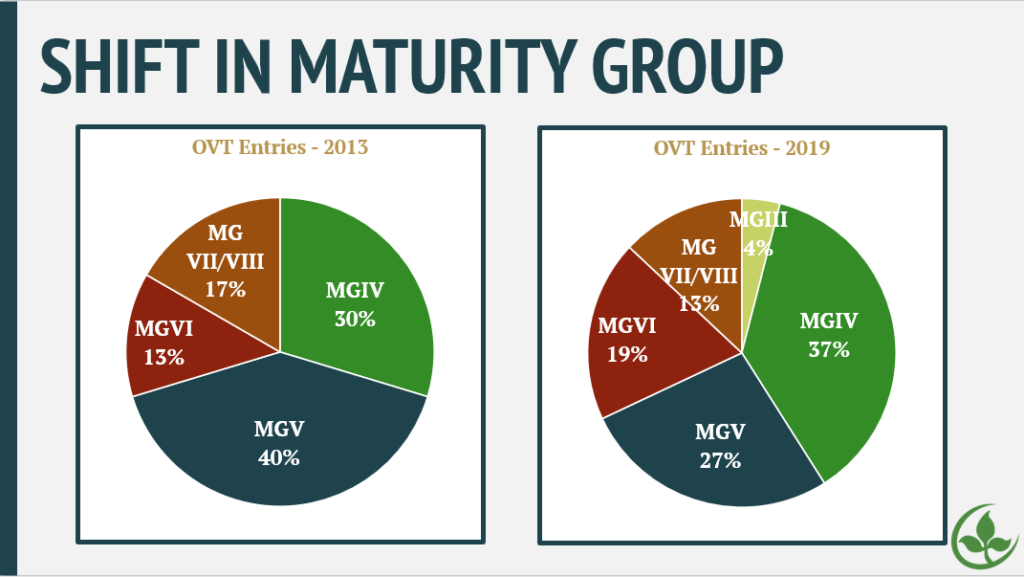
In addition to maturity group, we’ve also seen a slight shift in planting date over the last 5-10 years. If we look at the Percent Planting Progress Curve published by NCDA each week, you’ll notice a slight shift to an early planting date when comparing the average planting progress from 2012-2014 to 2015-2017 to 2018-2020. Specifically, if we zoom in around the mid-May timeframe, you’ll see percent planting progress shifted from an average of only 27% of the crop in the ground from 2012-2014 to about 35% in the ground by mid-May from 2018-2020. This suggests many growers across the state are shifting at least some of their planting dates up by a few weeks.
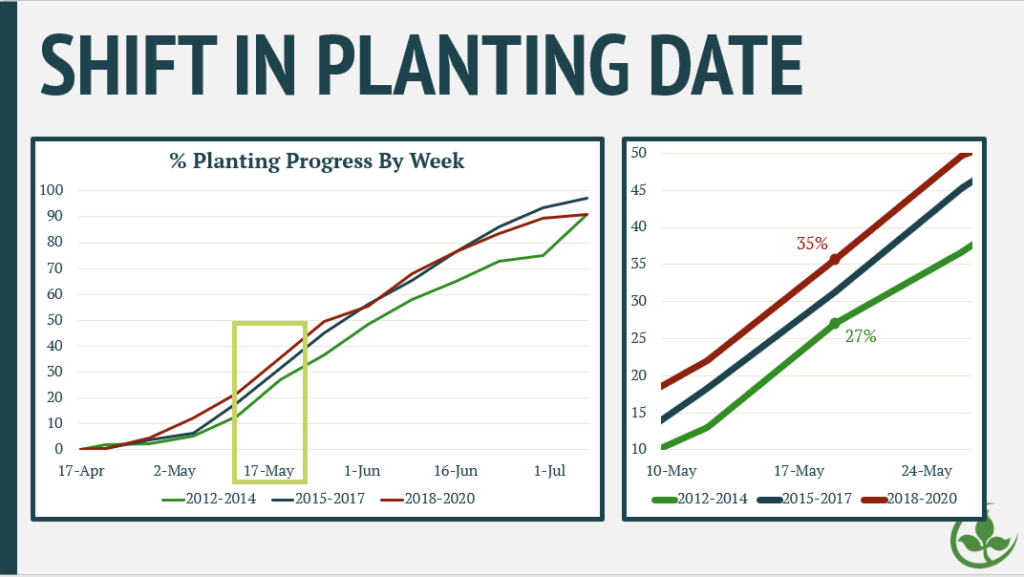
So a shift in planting date and a shift in maturity group means the environment those soybeans are experiencing, especially as they begin to mature may be very different compared to what we’ve traditionally seen in our state. We can look at estimated plant development over time to get an idea when earlier planted, earlier maturing varieties will be maturing and you will notice a group IV planted in late April matures almost a month before a group VI planted in late May. The group IV planted in late April will be ready to harvest around the middle of September while the group VI planted in late May wouldn’t be ready to harvest until mid-Oct.
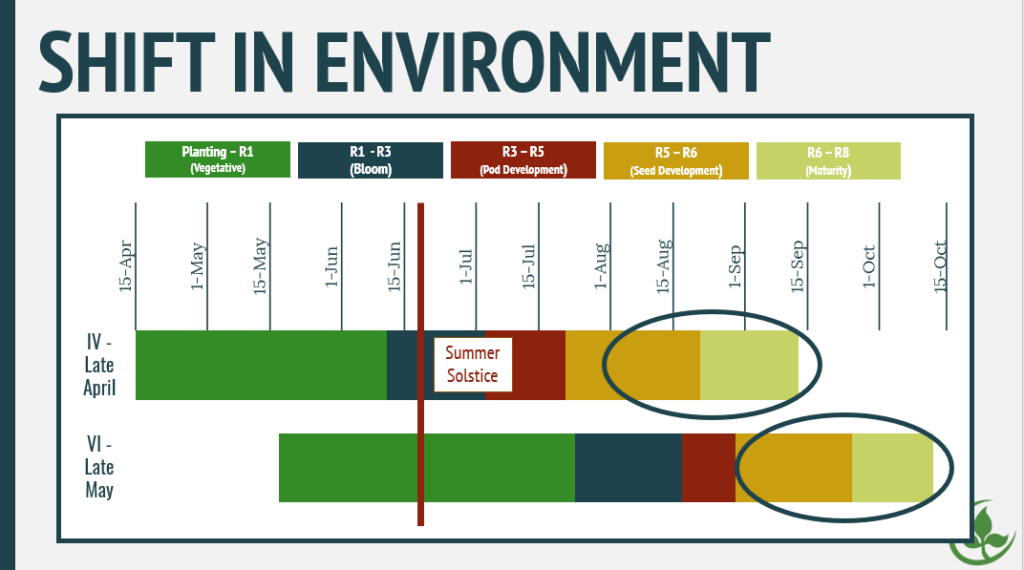
One advantage to the earlier production system is the plants are reaching R1 much closer to the summer solstice than they would with a later production system. This means they are able to capitalize on more sunlight during these critical periods, which leads to increased yields. But with every reward, there is a risk and the risk to that is the weather conditions in which they are maturing. By looking at historical rainfall patterns (last 10 years) across different regions of the state, you’ll notice the days with the greatest average rainfall are in late August/early September in both the Coastal Plain and Tidewater regions – right when the earlier planted/earlier maturing soybeans are drying down.
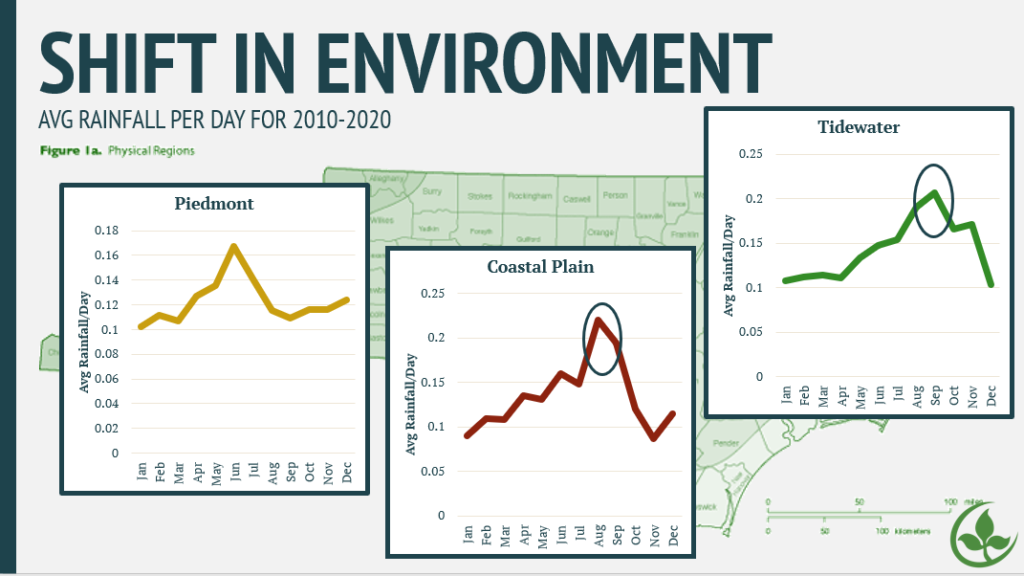
Since we know beans planted in the early production system are maturing in an environment which has a greater risk for seed quality issues, the obvious questions is what can growers do to combat this risk? One idea is to use harvest aids, to speed up the dry down period, and reduce green material, in turn allowing you to get the combine in the field a few days earlier, hopefully reducing the amount of time the beans are exposed to the elements so we designed a trial to evaluate that.
Harvest Aids 101
But before we get into the data here’s a quick refresher on harvest aids. Much of the work on harvest aids thus far has been done in the Midsouth, where growers adopted an early production system about 20 years ago. The information below is compiled from experts in Louisiana, Arkansas, and Tennessee.
At the very basic level, harvest aids desiccate green material to facilitate a more efficient harvest. Common approved products in soybeans include Gramoxone (paraquat), Sharpen (saflufenacil), and Defol 5 (sodium chlorate). There are a number of things harvest aids can help do, but there are also limitations.
Harvest aids CAN:
- Work to protect yield that has already been determined
- Improve harvest efficiency
- Protect seed quality
- Promote an earlier harvest
But, harvest aids WILL NOT:
- Change the maturity of the crop
- Increase yield
- Remove excessive moisture from seeds
- Protect the crop from shattering
Essentially, harvest aids can be used as a tool to protect what you have, but they’re not going to make something that’s not there.
Ideal Timing: Harvest aids should be applied at R6.5 or later. This is when seeds have separated from the white membrane in the pod and seed margins are prominently defined (or when upper canopy pods are at about 50% moisture)
*If applied too early, a harvest aid can significantly reduce yield, as immature seed never mature. Applying at R6 (60% moisture in upper canopy pods) instead of R6.5 reduced yield by 15%.
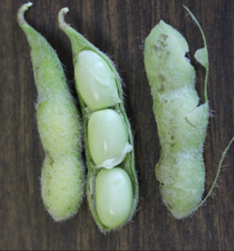
Harvest Aid Evaluation
To help answer the question “can harvest aids be used to improve seed quality” we carried out work at four sites across the state, two in the Tidewater regions and two and in the Coastal Plain region. Three different products were evaluated – Gramoxone, Sharpen, and Defol 5, and plots were harvested at three different timings – 3 days after a harvest aid application was made (DAA), 7 DAA, and 14 DAA. All harvest aids were applied when defoliation reached 65% (approximately R7). This was later than what was recommended in the Midsouth, but we wanted to make sure we did not sacrifice yield. An untreated control was also included in the study, which did not receive a harvest aid application. It was harvested at maturity (which was at about the same time as the 14 DAA harvest at all locations).
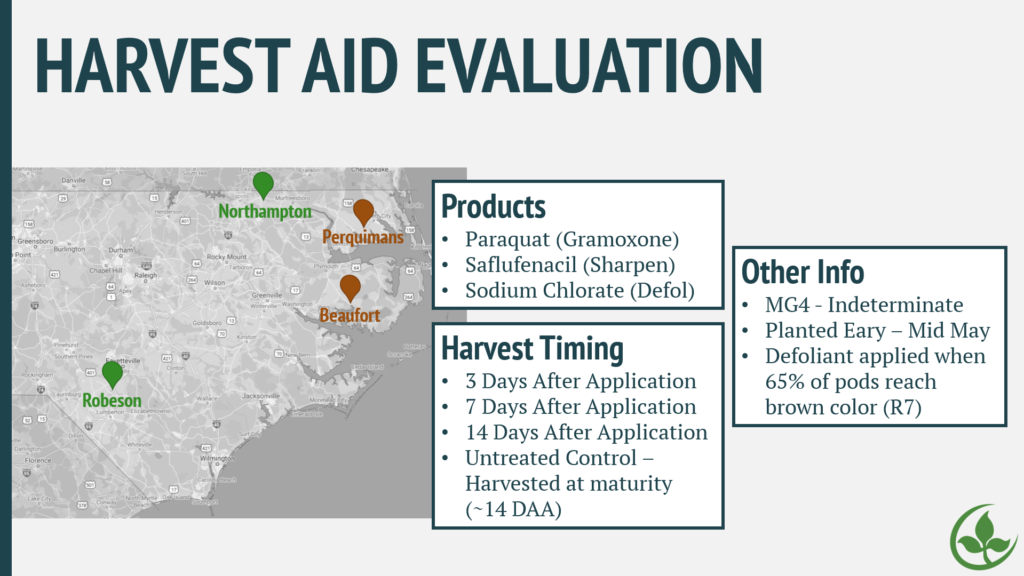
Damage
The hope of this work is we would identify a product and harvest timing combination that reduced damage in harvested beans, but spoiler alert – unfortunately that was not the case. When looking at % damage pooled across all locations and all products there were no significant differences in our treatments and the untreated check. We also saw no significant differences between the three products tested. This suggests, that at the timing of application and conditions present this year, a harvest aid will not help combat seed damage issues.

Yield
We know that a harvest aid will not increase your yield, but there are concerns that applying too early may negatively impact yield, so while the focus of this work was on seed quality, we wanted to evaluate yield as well. Across all timings and products, we saw no significant difference in yield compared to the untreated control. This suggests at the approximately R7 timing used in this trial, yield was not significantly impacted by the application of a harvest aid.
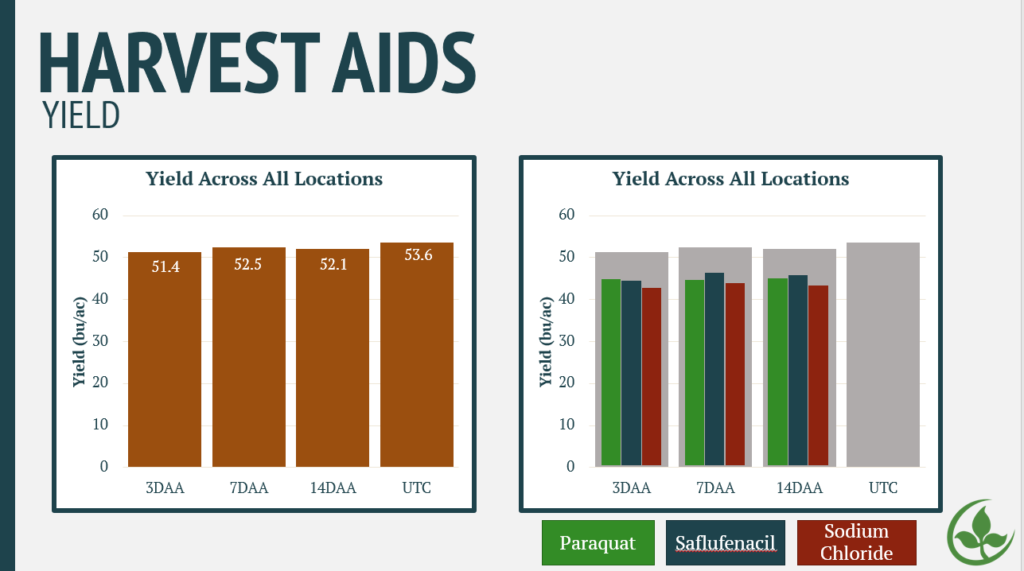
Green Material
One motivation of using a harvest aid is to reduce green material to aid in harvest efficiency. When we evaluated % green material (stem and leaves) present in each treatment we saw that there was a significant difference in harvest timing. Waiting 7 days after application to harvest versus 3 days reduced the % green material from 40% to 5%. There were no differences in product, suggesting any of these products would be appropriate to help reduce green material at harvest. This data suggests a harvest aid can be useful for reducing green material, especially if you are able to wait at least 7 days after application before harvest.
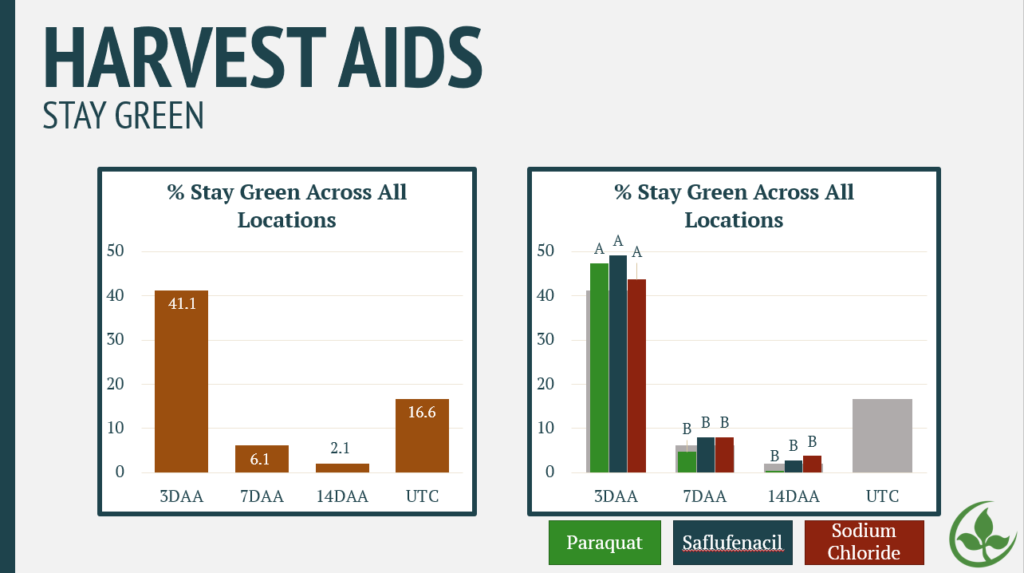
Days to Harvest
Another common reason to use a harvest aid is to reduce the days to harvest, therefore we evaluated this as well. Applying a harvest aid and harvesting 3 days after application saved about 10 days compared to the untreated control. The 7 DAA timing saved five days compared to the untreated control. This data confirms a harvest aid can help reduce the days to harvest. Saving five to ten days can make a big difference for a grower who is up against a weather event like a hurricane or low-pressure system.
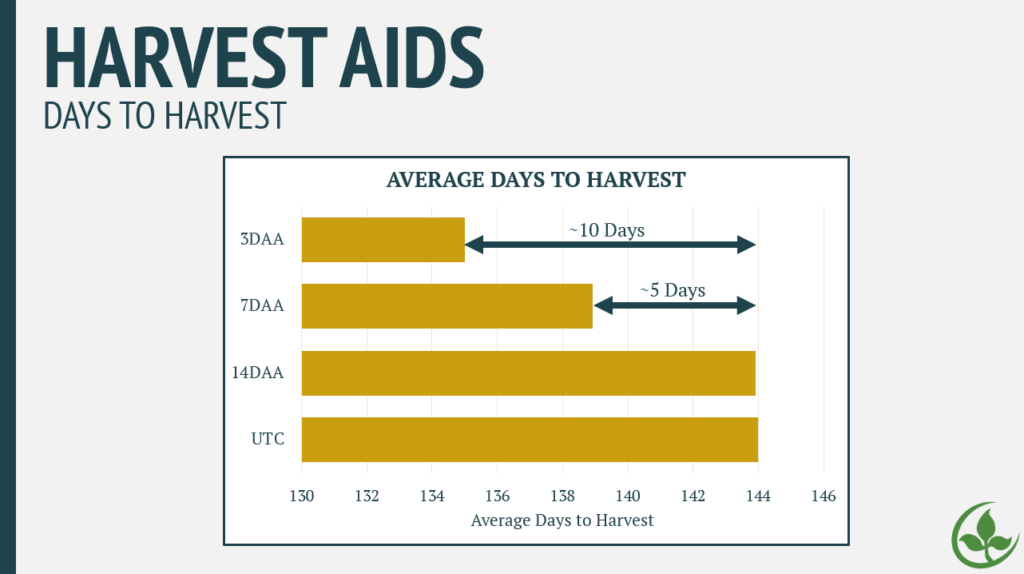
Conclusions
In looking at all this data combined, we see that while harvest aids did not impact damage and purple seed stain at the R7 timing they were applied in this trial, they may be useful for other reasons, like reducing the amount of green material present and speeding up the time to harvest. We also saw no differences in the three products tested regardless of the characteristic evaluated, suggesting any of these three products could be used successfully. These products all have different labels and slightly different modes of action, so there could be a time when one is more beneficial than another. It is important to remember to follow the label for any product used. The work done here was for experimental purposes, and therefore some of the combinations tested were not on-label, but we wanted to be able to compare across products.
While we weren’t able to provide a solution to the seed quality issues with this trial, we are looking forward to continuing this work in future years. The use of a late-season fungicide, as well as other application timings, will be investigated moving forward.
As always, don’t hesitate to reach out to Katherine Stowe if you have questions about this data!
We’d like to thank the NCSU Soybean Extension Lab (Dr. Rachel Vann) and her students for running all the soybean seed quality evaluations.







